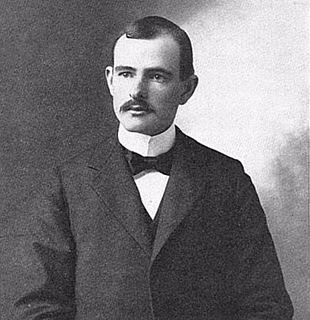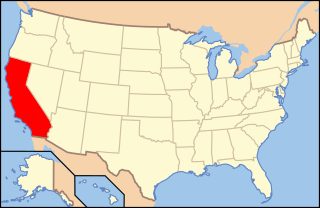Related Research Articles
The PaleozoicEra is the earliest of three geologic eras of the Phanerozoic Eon. The name Paleozoic was coined by the British geologist Adam Sedgwick in 1838 by combining the Greek words palaiós and zōḗ, "life", meaning "ancient life").

The West Humboldt Range is a short mountain range in the western Great Basin in northwestern Nevada in the United States.

Annie Montague Alexander was an explorer, naturalist, paleontological collector, and philanthropist.

John Campbell Merriam was an American paleontologist, educator, and conservationist. The first vertebrate paleontologist on the West Coast of the United States, he is best known for his taxonomy of vertebrate fossils at the La Brea Tar Pits in Los Angeles, particularly with the genus Smilodon, more commonly known as the sabertooth cat. He is also known for his work to extend the reach of the National Park Service.

Rollo Howard Beck was an American ornithologist, bird collector for museums, and explorer. Beck's petrel and three taxa of reptiles are named after him, including a subspecies of Galápagos tortoise, Chelonoidis nigra becki from Volcán Wolf. A recent paper by Fellers examines all the known taxa named for Beck. Beck was recognized for his extraordinary ability as a field worker by Robert Cushman Murphy as being "in a class by himself," and by University of California at Berkeley professor of zoology Frank Pitelka as "the field worker" of his generation.

Nectosaurus is a genus of thalattosaur which lived during the Late Triassic in what is now California. The type and only known species, Nectosaurus halius, was found in the Hosselkus Limestone and described by John C. Merriam in 1905, making it one of the first thalattosaurians known.

Joseph Grinnell was an American field biologist and zoologist. He made extensive studies of the fauna of California, and is credited with introducing a method of recording precise field observations known as the Grinnell System. He served as the first director of the Museum of Vertebrate Zoology at the University of California, Berkeley from the museum's inception in 1908 until his death.
Plotosaurus is an extinct genus of mosasaur from the Upper Cretaceous (Maastrichtian) of Fresno County, California. Originally named Kolposaurus by Berkeley paleontologist Charles Lewis Camp in 1942, it was changed to Plotosaurus in 1951 when Camp discovered the name had already been assigned to a type of nothosaur.

The University of California Museum of Paleontology (UCMP) is a paleontology museum located on the campus of the University of California, Berkeley.

Thalattosaurus meaning "sea lizard," from the Attic Greek thalatta (θάλαττα), "sea," and sauros (σαῦρος), "lizard," is an extinct genus of marine reptile in the family Thalattosauroidea. They were aquatic diapsids that are known exclusively from the Triassic period. It was a 2–3 metres (6.6–9.8 ft) long shellfish-eating reptile with paddle-like limbs and a down-turned rostrum occurring in the Lower and Middle Triassic Sulphur Mountain Formation of British Columbia as well as the Upper Triassic Hosselkus Limestone of California. It has gained notoriety as a result of studies on general diapsid phylogeny.
William Alvin Clemens Jr. was a paleontologist at the University of California at Berkeley. He was faculty of the Department of Paleontology from 1967, then the Department of Integrative Biology from 1994 to his retirement and curator of the UC Museum of Paleontology. Clemens was also director of the museum (1987–1989) and chair of the Department of Paleontology (1987–1989). He was awarded a Guggenheim Fellowship (1974–75), a U.S. Senior Scientist Award by the Alexander von Humboldt Foundation, the Romer-Simpson Medal (2006), and was made a Fellow of the California Academy of Sciences.

Toretocnemus is an extinct genus of ichthyosaur. Its remains have been found in California, United States, in Triassic layers of the Carnian Hosselkus Limestone.

Frank Elmer Peabody, was an American palaeontologist noted for his research on fossil trackways and reptile and amphibian skeletal structure.

Paleontology in California refers to paleontologist research occurring within or conducted by people from the U.S. state of California. California contains rocks of almost every age from the Precambrian to the Recent. Precambrian fossils are present but rare in California.
Eustace L. Furlong was a paleontologist and fossil preparator noted for his work on ancient mammals and the Mesozoic reptiles of California.
Acer traini is an extinct maple species in the family Sapindaceae described from isolated fossil samaras. The species was described from Miocene-aged fossils found in Canada and the United States of America. It is one of several extinct species placed in the living section Glabra.
Acer taurocursum is an extinct maple species in the family Sapindaceae described from a single fossil samara found in Late Eocene lakebed sediments exposed in the state of Nevada, US. It is one of several extinct species placed in the living section Rubra.
Acer eonegundo is an extinct maple species in the family Sapindaceae described from a single partial fossil leaf. The species is known from Eocene sediments exposed in the US state of Nevada. It is placed into the living Acer section Negundo.
Profidia is an extinct genus of leaf beetles in the subfamily Eumolpinae. It contains only one species, Profidia nitida. It is known from Oligo-Miocene amber found near Simojovel in Chiapas, Mexico.
Ruben Arthur Stirton (1901-1966), known to his friends as "Stirt", was an American paleontologist, specializing in mammals, who was active in South America, the United States and Australia. Stirton was closely associated with the University of California Museum of Paleontology, receiving an appointment as curator in 1930 and as its fourth director from 1949 to 1966. His career also saw engaged as a lecturer, associate professorship and then as a professor in 1951, from which time he was director of the University's Department of Paleontology.
References
- ↑ "The Saurian Expedition of 1905 participants". ucmp.berkeley.edu. Retrieved 2020-04-29.